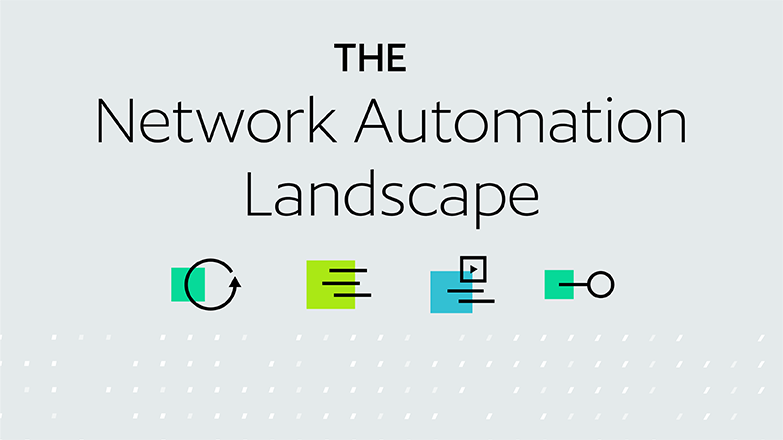The Network Automation Landscape

Despite an abundance of tools available to increase network security and efficiency, only 35% of enterprises use network automation according to Gartner. Survey respondents indicate 74% of all their network activities are manual, and to the chagrin of many overworked network administrators around the world, the “overall level of automation is just mediocre.”
The modern enterprise and enterprise-aspiring SMEs and SMBs rely on their networks to keep the business running. For network administrators, maintaining these networks involves tasks that are often repetitive, manual, and prone to human error. When things break and the network goes down, it can take days, even weeks, to identify the problem, fix it, and restore everything to the correct, secure configuration. Configuration backup and restore is one use case where network automation really shines, providing reliability and speed when it is needed most. Automation provides massive value in solving today’s network challenges, although the approach is often underused and misunderstood.
First, let’s examine the many challenges of managing today’s modern networks – all of which can be solved with automation.
Today’s Network Challenges
Network engineers have to efficiently manage hybrid environments consisting of both physical and virtual devices from multiple vendors in both public and private clouds, prevent network configuration disasters, manage alerts on performance and compliance issues, and forecast changes in hardware and configuration.
Routine configuration tasks take hours, even days to complete manually. A manual approach has obvious implications for productivity, and is susceptible to human error – which can introduce security vulnerabilities. If done through scripting, the scripts are often created and maintained by one or few individuals that create risk for the company when they leave, which is a significant consideration in today’s competitive job market for these skillsets.
Routine tasks like scheduled updates may be repetitive but that doesn’t make them any less critical. When they are put off, overlooked, or executed inconsistently, it can affect network performance and security. Many of these tasks are still completed manually.
Patch management can be a monumental task for network administrators. They must identify which patches are relevant to their environments, ascertain which patches have the highest priority, and ensure all needed patches have been implemented correctly. Network engineers are often bombarded with patches. For example, Oracle pushed a quarterly patch update that arrived with 520 fixes in Q1 of 2022, and this is just one vendor that may be represented in a hybrid network.
Common approaches to automation include vendor-supplied solutions that don’t play nice with other devices, or home-grown scripting developed and deployed within organizational siloes that often rely on individuals that can and do leave the company at some point.
Different levels of network automation
Network automation can solve all of these challenges. But due to the many different solutions that exist in the market with various levels of sophistication, the full benefits and capabilities of network automation are underutilized.
For example, for many, “network automation” today means a network admin writes a script that executes a specific task on a specific network device type. Devices made by different vendors have to be scripted in different ways, so managing the proliferation of automation scripts becomes a manual task of its own. BackBox’s approach to network automation is far more comprehensive. BackBox offers over 2,400 automations out-of-the-box, and in the event a custom automation tool needs to be made, it can be done without any knowledge of scripting languages and will reliably execute across all devices and device types in the network.
Without automation, it can take days to locate a problem in the network and fix it. An organization’s network could be down for weeks if there’s a forced shutdown without a backup or recovery contingency. BackBox offers automated tools to locate and fix problems with minimum downtime. In the event of a network shutdown, BackBox has a one-click recovery button option and offers easy GUI access to all backup files.
Backbox’s Approach to Network Automation
BackBox simplifies how enterprises, SMEs and SMBs maintain their network’s performance, security, and compliance in a multi-vendor, multi-device environment. It is a central repository for automating processes, security tasks, and device backup and restore. These tasks stack up without automation, quickly becoming unmanageable. BackBox automates day-to-day tasks, and can send/update configurations of many devices simultaneously.
Backbox eliminates the need for manual or scripted backup procedures, pulling files needed for recovery and keeping them in a secure location should the network need to be completely restored.
BackBox supports over 180 security and network devices, including Check Point, Palo Alto, Fortinet, F5, Cisco, VMWare and Symantec. Backbox can efficiently manage environments with multiple vendors, eliminating the need for multiple vendor specific management consoles or homegrown scripting. Other solutions have limited vendor integration capability, so network administrators still have to manually configure different devices and device types on the network. Backbox also allows network administrators to automatically implement patches and upgrades across an entire network in minutes, and run regular network health checks to spot problems before they impact performance.
Network automation has become a necessity for companies that want to scale their networks, maintain a sufficient security posture, streamline management tasks, and reduce burnout and risk.
We help companies save time, money and resources while enabling a more resilient network. Click here to connect with our team and learn how BackBox’s approach to automation can help you.


